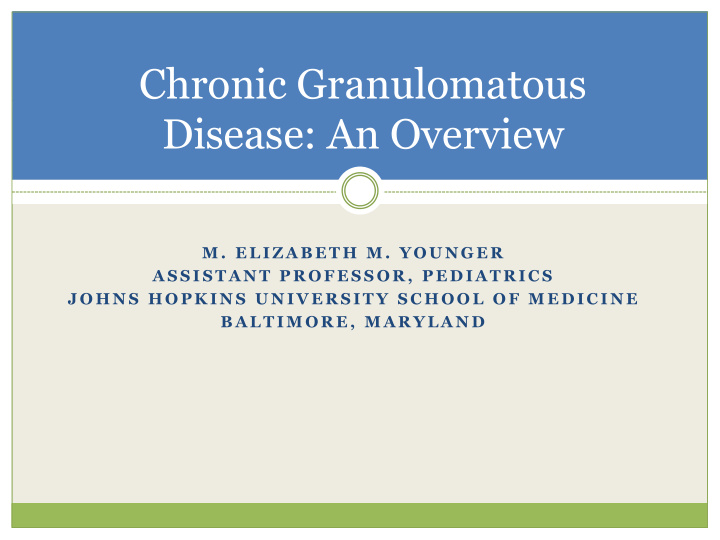



Chronic Granulomatous Disease: An Overview M . E L I Z A B E T H M . Y O U N G E R A S S I S T A N T P R O F E S S O R , P E D I A T R I C S J O H N S H O P K I N S U N I V E R S I T Y S C H O O L O F M E D I C I N E B A L T I M O R E , M A R Y L A N D
Disclosures C S L B E H R I N G : C O N S U L T A N T , R E S E A R C H S U P P O R T R M S : C L I N I C A L A D V I S O R Y P A N E L B I O P R O D U C T S L A B : A D V I S O R Y B O A R D H O R I Z O N P H A R M A : C O N S U L T A N T ; A D V I S O R Y B O A R D I M M U N E D E F I C I E N C Y F O U N D A T I O N : N U R S E A D V I S O R Y C O M M I T T E E
History First described in 1954: AMA Journal of Diseases of Children, 1954 And defined in 1959: AMA Journal of Diseases of Children, 1959
So What is CGD? A disorder of phagocytes (a type of white blood cell) Phagocytes cannot kill some bacteria and fungi because they cannot make an oxidative burst resulting in: Severe infections from “bugs” that would not necessarily cause a bad infection in someone without CGD Inflammation It is important to know that the other parts of the immune system (antibody production, complement activation, etc.) are NORMAL
White Blood Cells Types: Phagocytes are neutrophils and monocytes
Phagocytosis
Characteristics Inheirited disease X-linked inheritance Autosomal recessive inheritance ~1:200,000 births (in the US:~20 babies annually) Boys affected more than girls (~ 2:1) Usually presents in early years of life (aged 1-3) Presentation is usually acute or recurrent bacterial infections Sometimes presents as early onset inflammatory bowel disease
Age of Age at Diagnosis variable Age at Diagnosis of CGD CGD may present at any time from infancy to adulthood 1,2 Median age at diagnosis is 2.5 to 3 years 1 Age at diagnosis is older for people with autosomal recessive vs X-linked mode of inheritance 3-5 Adapted from van den Berg JM, et al. PLoS One . 2009;4(4):e5234. References: 1. Leiding JW, et al. Chronic granulomatous disease. GeneReviews . 1993-2017. 2. Wolfe LC, et al. Medscape website. http://emedicine.medscape.com/article/956936-clinical. 3. van den Berg JM, et al. PLoS One . 2009;4(4):e5234. 4. Jones LB, et al. Clin Exp Immunol. 2008;152(2):211. 5. Martire B, et al. Clin Immunol. 2008;126(2):155. (Slide used with permission of HorizonPharma)
X-linked inheritance x x xx xx x y xy xy xy-Male xx-female x-x chromosome carrying CGD
Autosomal Recessive Inheritance Both parents carriers of CGD One parent a carrier of CGD D D D d D DD DD D DD Dd d Dd Dd d Dd dd D-normal gene d-CGD gene
Autosomal Recessive Inheritance Both parents are carriers of CGD Both parents have CGD d d D d d D DD Dd dd dd dd dd d d Dd dd D-normal gene d-CGD gene
Diagnosis Assess the oxidative burst which is what kills the bacteria or fungi after the phagocytes attach to the germ and surround it Tests: Nitroblue tetrazolium test (NBT): Qualitative test-person has CGD or does not Dihydrorhodamine neutrophil burst assay (DHR); the “Gold Standard” Quantitative test that can distinguish between x-linked disease, autosomal recessive disease, and carrier status Limitations
Diagnosis: Nitroblue Tetrazolium Test negative positive (normal)
Presentation: Infections Especially in: Lymph nodes Lungs Liver Skin Caused by “CGD” pathogens (usually bacteria or fungi that produce an enzyme called catalase) Don’t get better or take a long time to treat with appropriate treatment Recur
Typical CGD Pathogens Staph aureus (50-60% of infections) Burkholderia cepacia Serratia marcesens Nocardia Candida Aspergillis
Presentation: Granuloma Formation Gastrointestinal system Granulomata found throughout the GI tract Can cause abdominal pain, diarrhea, strictures and fistulae Can mimic Crohn’s disease Genitourinary System In the bladder, urethra and ureters Can cause pain and obstruction
Co-morbidities (other illnesses) Autoimmune disease Eyes: inflammation of the cornea, retina and uvea Kidneys: IgA nephropathy Joints: Juvenile arthritis Myasthenia gravis Skin: Raynuad’s phenomena, light sensitivity, rash
Recommend
More recommend